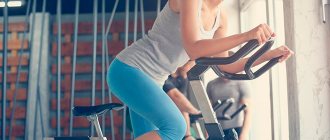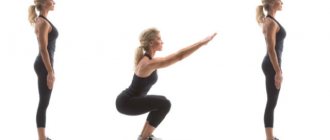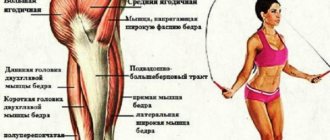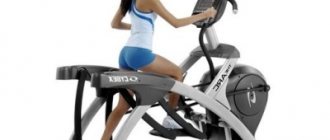You will burn:
Fat equivalent:
Push-ups are one of the simple ways to get a beautiful body shape and get rid of excess weight. These simple exercises, familiar to us from school physical education lessons, turn out to be no less effective than training in the gym. With the help of push-ups, you can slightly enlarge your chest, make your décolleté area beautiful, strengthen the muscles of your shoulders and arms, remove fat deposits in the abdomen and buttocks, strengthen your back muscles, while improving your posture.
To maintain the vital functions of the body, men need approximately 1,700 kcal per day; for women, 1,300 kcal is sufficient. In addition, there is a direct dependence on the individual characteristics of a person, his weight and the degree of physical activity. The intensity of physical activity directly affects the body's energy consumption.
The average person, doing mainly mental work, burns from 2200 to 2800 kilocalories. During intense physical work, energy consumption will be 3500-4000 kcal, and during very heavy physical activity - up to 5000 kcal.
Benefits of push-ups
- These exercises work different types of muscles at the same time. Push-ups work your shoulders, triceps, chest and other muscles.
- To perform the movements correctly, you need a strong core, which helps with daily activities because there is less strain on the spine. Regular exercise helps prevent lower back pain.
- Push-ups promote breast enlargement and the formation of a beautiful décolleté area. Exercises help to form a beautiful shape of the buttocks and abdomen, pump up the back muscles to improve posture.
- During training, proper breathing plays an important role. Inhale through your nose as you move down, and exhale through your mouth as you move up.
Push-up technique:
It is impossible to achieve all the benefits of push-ups without first warming up: this can be bending, swinging your arms and legs, rotating your shoulders - any small loads that help disperse the blood and saturate the body with oxygen. If you have no experience at all, you can do the exercise slowly. This method will help control technique and control movements. Regular exercise will help you build up your pace, and you will be able to burn calories due to the quality of the exercise, and not due to the duration of the workout.
A man under the age of 40 can do at least 30 push-ups, after 40 years - about 20 times. Women under 30 should easily do 12-16 push-ups, older women - about 10 times. For beginners, three approaches of 5-10 times are enough with a mandatory break between sets of 2-3 minutes. Then the load is increased to five sets of 20 times with a minute break. Start training with 2-3 sessions per week. You can start daily training after a month of regular training.
There are many variations of this exercise, but it is based on the general technique of classic push-ups.
Sequence of performing push-ups:
- Lie face down on the floor, resting your palms on it.
- Place your hands shoulder-width apart, spread your legs to the sides, resting your toes on the floor.
- As you inhale, lower your body, bending your elbows until a right angle is formed.
- As you exhale, raise your body to the original position.
IMPORTANT! Do not allow your body to bend in the lumbar region, as this may cause serious injury.
For people who have problems with the cardiovascular system, spine, or high blood pressure, it is better to refuse push-ups or consult a doctor.
Factors Affecting Calorie Expenditure When Performing Push-Ups
- Difficulty of push-up variations;
- Presence of burdens;
- Training intensity;
- Number of approaches and repetitions.
Everyone knows that to increase muscle mass you need to consume more calories than you expend. And to lose weight you need to spend more than you consume. Calorie consumption during push-ups is affected by difficulty, intensity and number of repetitions. The lowest energy consumption will be when performing simple options: from the wall, from a bench, from the floor from your knees. The ideal calorie expenditure is achieved at a heart rate of 120 beats per minute. This figure is achieved with heavy, intense training.
"Inappropriate" push-ups
Don't get carried away with push-ups alone - pay attention to training other parts of the body, otherwise you risk getting a disproportionate figure. Also objectively assess how serious your excess weight problem is. Push-ups are great for those who want to lose a few pounds or are trying to stay in shape. But if a person is too fat, then such an intense load can damage joints or bones - he needs to choose exercises together with a trainer and doctor.
For people who have problems with the heart, blood vessels, spine, or whose blood pressure rises from time to time, it is best to also look for a way to burn calories more easily. In any case, you should consult a doctor before training.
How many calories are burned with 100 push-ups?
If you have achieved a hundred push-ups in one set, then you are in very good physical shape and are guaranteed to spend about 90-100 calories for this approach. In the meantime, the exercises are difficult, and you are not sure of the correct technique - try to increase the number of calories burned by increasing the duration of the workout.
In most cases, push-ups have a positive effect. Muscle mass grows, calories are burned more energetically. After several months of training, you can see the result. The main thing is regularity of training, gradual increase in load and moderation. Since muscle recovery occurs during rest, you need to choose the optimal training regimen for yourself (3-4 times a week for a beginner athlete, 4-5 for a more experienced one). Excessive exercise can lead to muscle breakdown and weakened immunity.
Optimal time for training
Forget the myth that sports exercises are only effective in the morning. You can do push-ups in the evening, after work, or you can devote a few minutes to training during the working day, at lunch hour. The main thing is that classes are not scheduled right before bed or even at night. In this case, the body is unlikely to want to “part” with calories, but, unfortunately, you will cause harm to your health.
In addition, it is very important to remember to moderate the load. Exhaustion leads to the fact that the body begins to actively absorb fats, which, of course, is absolutely contrary to the goal of losing weight. Distribute your strength and move towards harmony step by step!
Briefly about calories and calorie content, their importance for the human body
Anyone has ever heard the word “calorie”. But not everyone understands what this really means. The term itself appeared to the world in the 19th century. French scientists used the word “calor” to describe the unit of combustion temperature. The famous chemist Wilbur Atwater divided foods into carbohydrates, fats and proteins. Since then, the entire energy value of the product began to be measured in calories.
Actually, in terminology, a calorie is the amount of heat with which the temperature of 1 gram of water increases by 1 gram Celsius. In classical physics, heat energy is measured in joules; in everyday life, it is customary to count it in calories.
Note! 1 calorie is equal to 4.1868 joules. Many people are scared by the word kilocalorie, but here everything is simple. There are 1000 calories in one kilocalorie.
Each person has the necessary minimum number of calories for the normal functioning of the body. Calories are needed for our life. They fill our body with energy, which is necessary for breathing, work, rest and even sleep. Energy nourishes our cells and gives them the opportunity to grow, divide and repair.
Calories enter our body in the form of food
Calories are presented in three types: fats, proteins, carbohydrates. Each energy component performs its own unique task:
- amino acids from proteins form new cells and muscle tissue;
- fats act as fuel;
- carbohydrates nourish cells.
Calories enter our body in the form of food that we consume. Depending on the diet, a person receives different amounts of energy. For example, 1 gram of proteins and carbohydrates contains 4 kilocalories, and 1 gram of fat contains 10 kilocalories. These components are absorbed by the body in different ways. For example, calories derived from proteins or complex carbohydrates require significant amounts of energy to be fully absorbed.
Not the most necessary calories are found in sweet and fatty foods, in the so-called fast carbohydrates (baked goods, sausage, processed foods). Such food is already processed, so it does not require a large amount of energy consumption to absorb it. A minimum amount of calories is consumed, and the body converts the remainder into fat.
After repeated studies of the human body, scientists concluded that the calorie diet should consist of 25–30% proteins, 20–30% fats and 40–55% carbohydrates. Each person can create their own calorie consumption calculator and prepare an individual diet, taking into account their body type and activity.
Advice from experienced coaches and athletes
Push-ups, according to trainers, are a basic exercise for many strength sports. In addition, this activity has proven itself well for general physical training. It is necessary to start push-ups with light loads, and best of all with the participation of an experienced trainer. First of all, you should create a class schedule taking into account individual preparedness.
Try to do the first 10 push-ups, and if everything goes well, you can add more. But you shouldn’t forget about rest. There is no need to immediately exhaust yourself with heavy loads. The main thing here is not repetition, but execution technique, which is much more important.
Before the exercise, you need to decide on your breathing. This is done as follows: inhale through the nose - lower, hold your breath, rise - exhale through the mouth. Then a short warm-up for 10 minutes, and after that, perform the planned push-ups, in pauses of which you need to rest every 2-3 minutes.
It is important! There is no need for haste here. You need to focus solely on your physical fitness. If there were no serious difficulties at the previous stage, you can move to the next level.
If preparation does not cause problems, then you can gradually increase the load by rearranging your hands (changing the distance between them, placing one fist or removing one hand). You can also load your legs more, for example, by moving them from the floor to the beam.
About the rate of consumption and burning of calories by a person depending on lifestyle and physical activity
How many calories are burned when cycling?
There is a necessary minimum for the survival of the human body. It is 1680 kcal for an adult man of average weight, and 1330 kcal for an adult woman. People also spend their calories differently. Someone spends time in the gym, another sits at the bar with a glass of beer. Energy consumption will be radically different.
The profession in which a person is engaged largely determines his energy consumption. After all, you have to spend most of your active time at work. It is worth considering in detail how many calories are spent on different jobs:
- office work that does not require muscle expenditure. Example of a profession: receptionist, librarian, office worker spend approximately 2200–2500 kilocalories;
- little muscle activity while sitting. The labor of a teacher, seller, or jeweler costs 2650–2800 kilocalories;
- work associated with movement and slight muscle load (doctor, postman, waiter). Their consumption is about 3000–3150 kilocalories;
- intense muscle work - the work of a mechanic, fitness trainer, painter requires expenditures of up to 3500 kilocalories;
- heavy physical labor: loader, shop worker, athlete - a little more than 4000 kilocalories;
- very heavy physical activity, costs up to 5000 kilocalories. This is the work of a miner, metallurgist, mason.
We can conclude that mental work on calories is less expensive. This means that if the work is not very physically tiring, then you need to seriously think about proper nutrition and regular physical activity.
Regular physical activity is important
Exercise outside the home
burning calories in the fresh air occurs faster than indoors
It is easy to believe in favor of cyclic sports with aerobic exercise (deep breathing at an increased heart rate) by looking at their representatives. Swimmers, runners, cyclists, and skiers are slim, fit, and lean.
If you make an average rating of sports based on the number of calories consumed per 1 kg of body weight, it looks like this:
- 5th place - riding, skating (5.167);
- 4th place - training in the gym (5.2);
- 3rd place - outdoor games like football, basketball, etc. (6.273);
- 2nd place - water sports (6.625);
- 1st place - running (9.00).
A guaranteed way to burn extra calories is running - moving for an hour at a speed of 12 km/h will burn 700 kcal, at a speed of 8 km/h - 560 kcal.
Walking up the stairs is even cooler - in 60 minutes the body will thank you by losing 900 kcal. Cycling uses fewer muscles than running, resulting in a 15-20% reduction in calorie burn.
Winter types of physical activity require energy expenditure not only for movement - the lion's share of calories is spent to warm the body. During an hour of ice skating, a person loses 700 kcal, and skiing - up to 900 kcal, depending on the conditions.
Don't think that warm clothes prevent you from expending extra calories and don't neglect protection from freezing.
The same goes for swimming. When in water, the human body experiences stress, accompanied by the release of calories in order to warm the body. Swimming for an hour at a speed of 10 m/min burns 215 kcal, and at a speed of 50 m/min – 720 kcal.
Jumping on a trampoline is considered an excellent method for losing excess weight. If you spend 15 minutes exercising, the calories burned are comparable to an hour of training on a treadmill.
How many calories do you burn when playing different sports (video review):
For comfortable assimilation of the information presented below is a table of calorie consumption for a person weighing 70 kg.
Table 1. Calorie consumption during activity at home.
| Type of activity | Hourly calorie consumption, kcal |
| Jumping rope | 750 |
| Push-ups, abdominal swings, unloaded squats, pull-ups | 250-550 |
| Horizontal plank on straight arms | 300 |
| Dumbbell plank | 900 |
| Slow dance (waltz, tango, ballroom) | 215 |
| Fast dance | 450 |
| Twisting a hoop around the body | 600 |
| Simple muscle stretching | 125 |
| Static yoga | 230 |
| Lying position without sleep | 80 |
| Dream | 50 |
Table 2. Calorie expenditure during activities outside the home.
| Type of activity | Hourly calorie consumption, kcal |
| Cycling (20 km/h) | 540 |
| Moderate running (12 km/h) | 700 |
| Light jogging (8 km/h) | 560 |
| Running up the steps | 900 |
| Skiing on flat surfaces | 500 |
| Skiing down the mountain | 900 |
| Calm ice skating | 700 |
| Snowboarding from the mountain | 800 |
| Slow breaststroke | 400 |
| Fast breaststroke | 460 |
| Slow crawl swimming | 490 |
| Fast crawl swimming | 570 |
Any type of physical activity will help you lose weight by burning calories. When choosing, you need to rely on the amount of free time and current sports conditions.
If you find an error, please select a piece of text and press Ctrl+Enter.
Source










